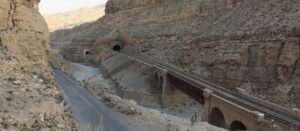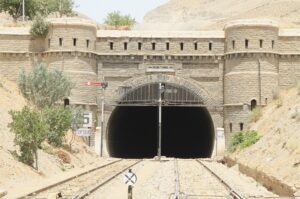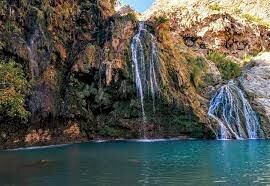Bolan Mach (بولان مچھ)
Balochistan is blessed with natural beauty, historical places, mountain ranges, fruits, and minerals. Bolan Pass is a gateway to South Asia, connecting Jacobabad, Sibi, and Quetta. It is also famous for its tunnels.

This pass connects Balochistan to upper Sindh and Punjab. Both the Road and train tracks can be used for this. The interesting fact about Bolan is that the train passes through 21 tunnels and gives a thrilling feel.
Key info about Bolan Mach
| Attribute | Information |
|---|---|
| Location | Balochistan Province, Pakistan |
| Bolan Pass Length | Approximately 120 kilometers (75 miles) |
| Mach | A town in the Bolan Pass region |
| Geography | Mountainous terrain with rugged landscapes |
| Historical Significance | Part of the ancient trade route known as the “Bolan Pass,” used for centuries |
| Climate | Arid and dry with hot summers and mild winters |
| Vegetation | Sparse desert vegetation and rocky terrain |
| Tribes | Inhabited by various Baloch tribes |
| Economy | Livestock farming, agriculture, and trade |
| Transportation | Served as a key transportation route connecting Balochistan to other regions |
| Notable Features | Natural beauty, the “Bolan Train Safari,” and the picturesque Mach Valley |
| Wildlife | Home to various species, including leopards, wolves, and various bird species |
| Challenges | Water scarcity, limited infrastructure, and difficult living conditions |
| Accessibility | Accessible via road and rail, with the Bolan Pass route being a historical trade and travel corridor |
| Local Culture | Rich Baloch cultural heritage and traditions are an integral part of life in the region |
| Tourism | Attracts tourists and adventure seekers interested in the scenic beauty and local culture |
Khojak Tunnel
From 1857 to 1858, Quetta, Sibbi, and Chaman railway tracks were constructed because of Russian attack threats in the subcontinent. There was a threat of a Russian attack on India from Bolan Pass. In 1850, some graves of Russians were found in the Sibi, which gives a clue of their presence.
In 1876, The Britishers conquered Quetta and its nearby areas. They devised a railway track plan from Qandahar to Sukkar. This project was initiated in 1879 but it was postponed. The railway line ended at Chaman. In this way, Chaman was the last station toward the Afghan border.

Kojak pass was a hurdle for reaching Chaman so it was changed into the tunnel. Regular work started on 14th April 1886. There was a shortage of water because of a dry mountain range in the area. 80 tons of water were brought there by train.
Many people died of Pneumonia due to cold winds during the winter season. 800 masons died because of typhoid in just four months (1890-1891). For lightening the tunnel, a large mirror is placed on the trolly and the reflection of the sun is sent to the tunnel. The tunnel gets illuminated through this process. This process is still in practice.
This tunnel has a height of 5394 feet above sea level at the Shela Bhag station which is 113 km from Quetta. Constructed in 1891, it was the largest tunnel in Asia with a length of 3.91 km. Now, the Lowari tunnel has broken this record with a length of 8.6 km.
In 1976, Khojak tunnel picture was printed on the five-rupee currency note. These currency notes remained in circulation till 2005.
Pir Gaib
About 70 km away From Quetta to Sibi, and in the middle of Bolan Pass, Mach city is famous for its dangerous jail. There is a signboard of “Pir Gaib” on the national highway about 16 km from Mach City.

It is better to have a four-wheeled vehicle to travel beyond this area. A route directs to mountains from the center of Bolan Pass. Balochistan’s famous recreational spot “Pir Gaib” is 2 km from the Khajoori village.
Here the water of spring with constant speed, flowing from the naturally made rocky ponds, making its way through mountains, falls in the form of an enchanting waterfall among the lush green palm trees. Sitting in the shade of a nearby palm grove has its own fun.
Exploring Bolan Mach
Historical Significance
Trade and Connectivity
At the heart of Bolan’s history lies the Bolan Pass, a historically significant trade route. This ancient passage has connected civilizations, serving as a lifeline for traders, explorers, and conquerors for centuries.
Sibi Fort
As a testament to the region’s historical importance, Sibi Fort stands proudly, overlooking the landscape. It narrates stories of bygone eras when empires vied for control over these strategic routes.
Bolan
Geography and Climate
Bolan’s geography is a masterpiece of rugged terrain and imposing mountains, with the iconic Bolan Pass carving through the landscape. The district experiences a hot desert climate, where scorching summers yield to mild winters, creating a dynamic and challenging environment.
Wildlife
Bolan is not just about arid landscapes; it’s a haven for diverse wildlife. Various species of birds and mammals find refuge in this region, adding to its ecological significance.
Cultural Richness
Language and Traditions
Balochi and Brahui echo through the air, reflecting the linguistic diversity of Bolan. The district boasts a vibrant tapestry of traditions, from the poetry of the nomadic tribes to the lively dances that celebrate their heritage.
Festivals and Celebrations
Bolan comes alive with vibrant festivals. The Bolan Pass witnesses a unique blend of cultural celebrations during events like Sibi Mela, where music, dance, and local crafts take center stage.
Challenges and Triumphs
Economic Pillars
Agriculture and livestock form the backbone of Bolan’s economy. Wheat, barley, fruits, and dates are cultivated, sustaining the local communities.
Challenges
While Bolan thrives with natural beauty and cultural richness, it faces contemporary challenges. Infrastructure development and resource accessibility are key concerns that the district continues to address.
Schools and Colleges
- Government High School, Bolan Mach
- Bolan Mach Model College
- Al-Falah School and College, Bolan Mach
- Bolan Mach Public School
Hospitals and Healthcare Facilities
- Civil Hospital Bolan Mach
- Bolan Mach Medical Center
- Al-Noor Hospital, Bolan Mach
Restaurants and Eateries
- Bolan Grill and Restaurant
- Spice Delight Fast Food, Bolan Mach
- Khan’s Biryani Corner, Bolan Mach
- Desert Flavors Café
Frequently Asked Questions (FAQ)
What is Bolan Mach known for?
Bolan Mach is known for its unique combination of rugged landscapes, historical significance, and cultural richness. The region is often appreciated for its scenic beauty and the Bolan Pass.
Are there educational institutions in Bolan Mach?
Yes, Bolan Mach is home to various educational institutions, including schools and colleges such as Government High School, Bolan Mach Model College, Al-Falah School and College, and Bolan Mach Public School.
What healthcare facilities are available in Bolan Mach?
Bolan Mach has healthcare facilities, with notable options including Civil Hospital Bolan Mach, Bolan Mach Medical Center, and Al-Noor Hospital.
Tell me about the dining scene in Bolan Mach. Any recommended restaurants?
There are several restaurants and eateries in Bolan Mach, offering a variety of cuisines. Some popular options include Bolan Grill and Restaurant, Spice Delight Fast Food, Khan’s Biryani Corner, and Desert Flavors Café.
What landmarks or attractions can be found in Bolan Mach?
Bolan Mach is known for the Bolan Pass, a historical trade route that has played a crucial role in connecting civilizations. Additionally, the region boasts scenic spots and natural beauty.
What festivals or events are celebrated in Bolan Mach?
Local festivals and events in Bolan Mach often reflect the cultural vibrancy of the region. The Bolan Pass and surrounding areas may witness celebrations during significant occasions.
How is the climate in Bolan Mach?
Bolan Mach experiences a climate typical of arid regions, with hot summers and mild winters. The terrain and climate contribute to the unique ecosystem of the area.
Are there any ongoing development projects in Bolan Mach?
Information on ongoing development projects may vary, but efforts are often made to address infrastructure needs and enhance the overall quality of life in Bolan Mach.
What challenges does Bolan Mach face?
Like many regions, Bolan Mach may face challenges related to infrastructure development, resource accessibility, and other community-specific concerns.
Tell me about wildlife in the Bolan Mach region.
The Bolan Mach region may host diverse wildlife, including various bird species and mammals. Preserving this biodiversity is often a consideration in local conservation efforts.
How accessible is Bolan Mach?
Bolan Mach is accessible by road, and its strategic location makes it a point of interest for those traveling through the Bolan Pass.
Wind Up Lines
Bolan Pass is a pathway for traders and a tourist spot for travelers. It is a historic place of province Balochistan. In Bolan, the whispers of history blend seamlessly with the winds that sweep through the Bolan Pass. It is a district where the echoes of ancient trade routes harmonize with the vibrant beats of cultural celebrations.
